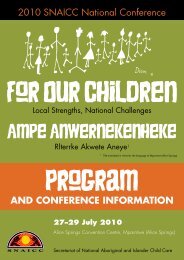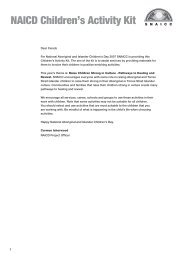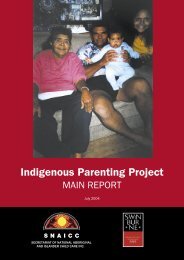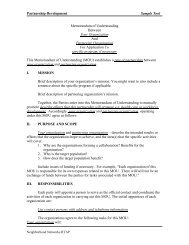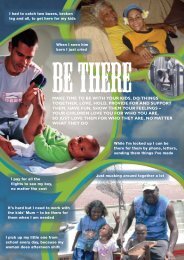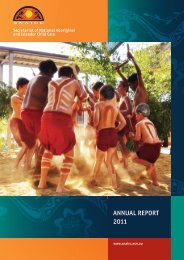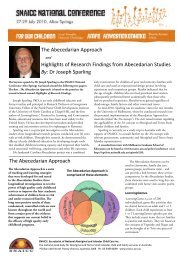View / Download Document - Secretariat of National Aboriginal and ...
View / Download Document - Secretariat of National Aboriginal and ...
View / Download Document - Secretariat of National Aboriginal and ...
You also want an ePaper? Increase the reach of your titles
YUMPU automatically turns print PDFs into web optimized ePapers that Google loves.
Images on these pages are <strong>of</strong> children at Ampe Kenhe Apmere (Congress Child Care Centre) in Alice<br />
Springs, which has designed its learning environments to accommodate family groups.<br />
Margaret illustrates how this approach supports<br />
children to assist <strong>and</strong> nurture each other,<br />
describing how she recently witnessed a young<br />
child climbing a plank, with an older child<br />
st<strong>and</strong>ing holding the plank steady. She explains<br />
how the older child “was giving him a chance to<br />
actually explore slowly but he was there guiding<br />
him.”<br />
Congress has paid particular attention to designing<br />
its learning environments to accommodate<br />
family groups. To meet the challenge <strong>of</strong> multiple<br />
ages in one setting, it has designed environments<br />
that cater to any age group, <strong>and</strong> have opened the<br />
centre up so children are free to play indoors or<br />
outdoors.<br />
Initially staff found that by having all activities<br />
available in all rooms some activities weren’t getting<br />
used, as Margaret explains, “because there<br />
wasn’t enough <strong>of</strong> them in every room <strong>and</strong> there<br />
wasn’t a good space”.<br />
They therefore redesigned their approach to create<br />
specialised rooms within the centre, including<br />
rooms for creative arts, scientific discovery <strong>and</strong><br />
construction, finer arts, <strong>and</strong> a room for quieter<br />
activities <strong>and</strong> finer cognitive work.<br />
While they have a st<strong>and</strong>ard way that each room is<br />
set up, educators explore what they need to add,<br />
take away or change to enhance the children’s<br />
experience in this area according to their interest.<br />
Following staff training on brain development <strong>and</strong><br />
trauma, staff discussed how child care environments<br />
do not provide children with opportunities<br />
for breaks during the day.<br />
Their new learning environment therefore affords<br />
children opportunities for time out, as they can<br />
choose to remove themselves from environments<br />
whenever they wish <strong>and</strong> go outside or to a quiet<br />
space.<br />
Margaret believes that it is vital for children to<br />
have time when they can withdraw <strong>and</strong> be quiet,<br />
<strong>and</strong> also to have control over which environment<br />
they want to be in. She says: “I think that’s<br />
another one <strong>of</strong> the reasons why some <strong>of</strong> the<br />
behaviour issues have disappeared too, so that<br />
children who want to be by themselves can actually<br />
find…a quiet space right away.”<br />
Based on a discussion with then Congress Branch<br />
Manager Margaret Harrison, conducted in May<br />
2012.<br />
SNAICC Annual Report 2012 43





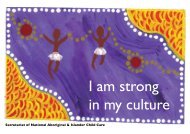
![Kukumbat gudwan daga - really cooking good food. [PDF 716 KB]](https://img.yumpu.com/47617674/1/190x134/kukumbat-gudwan-daga-really-cooking-good-food-pdf-716-kb.jpg?quality=85)
